 Facebook
Facebook
 X
X
 Instagram
Instagram
 TikTok
TikTok
 Youtube
Youtube
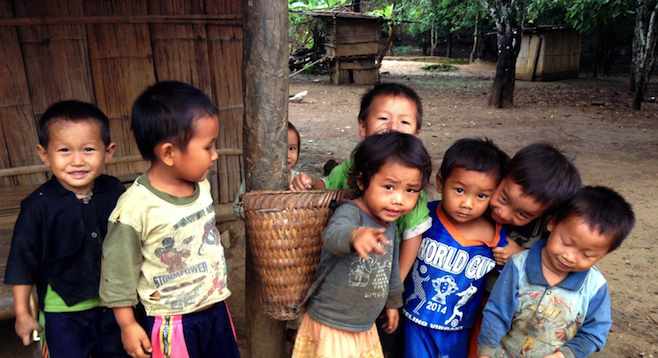
It was still dark outside when the roosters' crows aroused me from my slumber.
Surrounded by a mosquito net in an unfamiliar cabin, the aching of my body from the previous day's excursion reminded me where I was. I remained wrapped in my sleeping bag, listening to the animals' music and the villagers' footsteps as they started the day's work, and I recalled how I got to be here...
Bumping along the unpaved roads of northern Laos, we'd driven two hours from Luang Prabang city the previous morning. At Nam Song river, we paid a local woman a nominal fee to carry us across the river in her shabby wooden canoe. Once on the other side, it would be a six-hour trek to our overnight destination: a remote Hmong village in the mountains.
With our trusty Hmong guide, Sowlee, leading the way, I was astonished to see such a diversity of landscape – jungle, mountains and rice paddies all in close proximity.
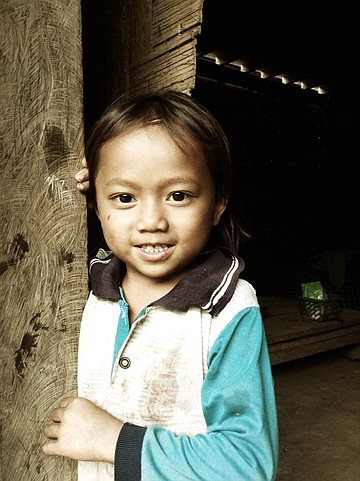
Nearly there, we made our final pit-stop at a remote Khmu village. Sowlee and the hordes of giggling Khmu children encouraged us to snap photos; the digital camera screen was their only opportunity to see themselves.
After bidding the Khmu people farewell, it was just one more hour of walking to go – this time in the pouring rain. Cold and mud-soaked, alas, we arrived at a Hmong village where Sowlee was greeted by smiling faces who called him “brother” and “son,” despite being unrelated.
Through Sowlee's translation of his native Hmong language, we were offered the use of the village water tap to rinse off the mud caked on our bodies. As clean as we were going to get that night, we gathered around the fire for warmth and helped our hosts prepare a meal I will forever remember. It's not as if the meal was so complex: stir-fried vegetables, steamed rice and a bowl of chicken soup. And it was cooked with little in the way of seasoning. But never have I had such a flavorful meal – rice so perfect, vegetables naturally juicy and chicken freshly butchered.
Our bellies satisfied, Sowlee offered more about the tribe's lifestyle that was so estranged from our own. His knowledge came from firsthand experience, having grown up in a neighboring Hmong village until his tribe migrated to the city a decade ago.
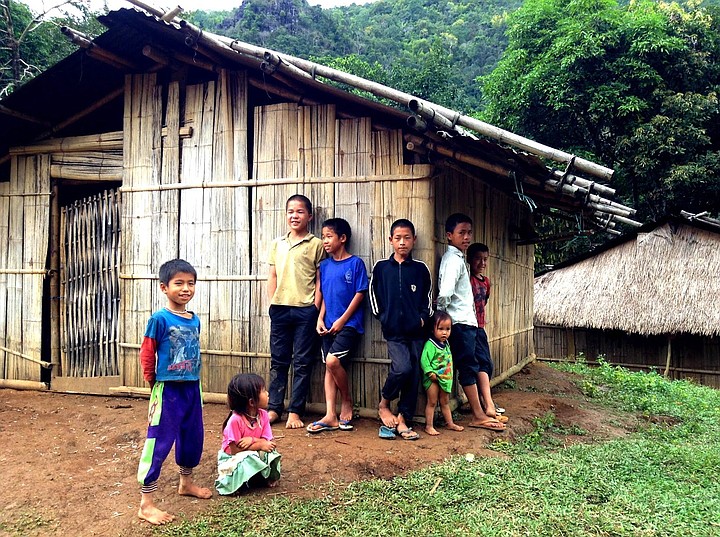
To the outsider, Hmong and Khmu villagers seem to live similarly primitive lifestyles, though they originate from distant regions and have completely different languages. Their houses are basic bamboo or straw structures with dirt floors; each tribe has their own style of construction. Hmong people are said to have emigrated from China, while Khmu come from what is now Cambodia. Both modern-day Khmu and Hmong tribes inhabit remote elevated locations in Vietnam, Thailand, Myanmar and Laos, and typically maintain amicable neighborly relations with one another.
The hill tribes live separately from society and are self-sufficient: they hunt for their food, grow their vegetables, raise farm animals in their village and harvest rice paddies. According to their varying animist religious beliefs, the village shaman is called to heal illness rather than Western medicine.
Their lives do not revolve around money in the same way ours do, though they are not immune to Laos governmental taxes. Only the head of each family will make the five-hour trek and two-hour drive into the city to get supplies in town a couple times per year. Families of 6-12 children are the norm. Often families cannot afford to pay the meager schooling fee for all of their children, so decisions must be made on who of their clan will stay behind to tend the fields and housework. Without electricity, the villagers go to bed shortly after dinner, as they rise around 4 a.m. to begin working. We too crawled into our sleeping bags following the schedule of the sun.
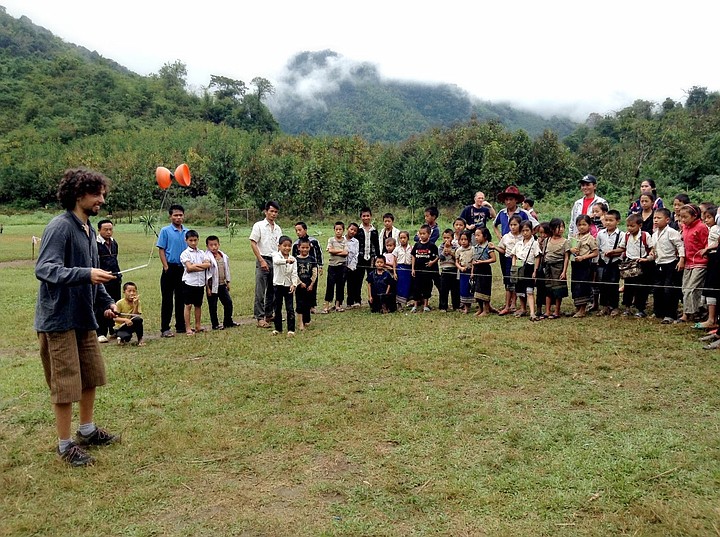
With the fond memories of yesterday fresh in my mind, I was ready to rise for another day of trekking. After a light breakfast and a thankful goodbye to our hosts, we made our way out of the village – but not before stopping at the local school. We arrived during recess, and fellow trekker Julian from Argentina entertained the schoolchildren with his diabolo skills (left).
When the students were eventually ushered back into the bamboo-hut classroom, we were offered the opportunity to teach a guest lesson. The students study in Lao, as it is the common language between Hmong and Khmu people. There's no English on the curriculum in Laos governmental schools. Having recently taught English in Thailand, I stepped up in front of the hut full of wooden benches and taught them some of the first English words they'd ever heard.
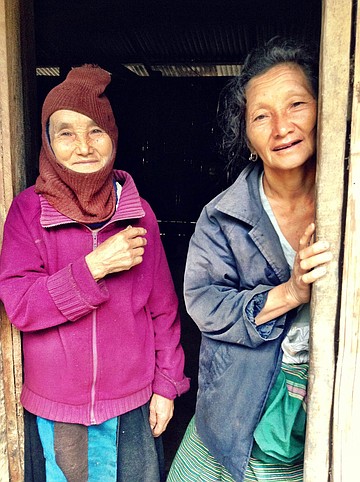
We stopped at one more Hmong village to refuel with food on our way out of the mountains. The entire village gathered around to watch in awe as we devoured our pumpkin curry lunch.
In any other situation, having 20-30 people staring at you eating might be a bit uncomfortable, at best. With their eyes popping out of their head as if they were watching a highly fascinating TV program, it was at this moment that I realized just how foreign we were to these people. Any inhibitions I previously had about making the kind villagers feel uncomfortable went away when I noticed they were just as intrigued as me as I was with them, in knowing that other human beings were out there who lived an existence totally unlike their own.
Hours later of trudging through thick mud, we finally made it out near a different remote river. Using a combination of hitchhiking and walking, we finally reunited with our driver, and eventually civilization.
That night, tucked into a comfortable warm bed in a clean hostel, I wondered if any villagers were lying in their bamboo huts reminiscing of the foreign visitors, as I was thinking of them. After all, as goes the popular phrase in Southeast Asia, "We're all just the same, same, but different."


It was still dark outside when the roosters' crows aroused me from my slumber.
Surrounded by a mosquito net in an unfamiliar cabin, the aching of my body from the previous day's excursion reminded me where I was. I remained wrapped in my sleeping bag, listening to the animals' music and the villagers' footsteps as they started the day's work, and I recalled how I got to be here...
Bumping along the unpaved roads of northern Laos, we'd driven two hours from Luang Prabang city the previous morning. At Nam Song river, we paid a local woman a nominal fee to carry us across the river in her shabby wooden canoe. Once on the other side, it would be a six-hour trek to our overnight destination: a remote Hmong village in the mountains.
With our trusty Hmong guide, Sowlee, leading the way, I was astonished to see such a diversity of landscape – jungle, mountains and rice paddies all in close proximity.

Nearly there, we made our final pit-stop at a remote Khmu village. Sowlee and the hordes of giggling Khmu children encouraged us to snap photos; the digital camera screen was their only opportunity to see themselves.
After bidding the Khmu people farewell, it was just one more hour of walking to go – this time in the pouring rain. Cold and mud-soaked, alas, we arrived at a Hmong village where Sowlee was greeted by smiling faces who called him “brother” and “son,” despite being unrelated.
Through Sowlee's translation of his native Hmong language, we were offered the use of the village water tap to rinse off the mud caked on our bodies. As clean as we were going to get that night, we gathered around the fire for warmth and helped our hosts prepare a meal I will forever remember. It's not as if the meal was so complex: stir-fried vegetables, steamed rice and a bowl of chicken soup. And it was cooked with little in the way of seasoning. But never have I had such a flavorful meal – rice so perfect, vegetables naturally juicy and chicken freshly butchered.
Our bellies satisfied, Sowlee offered more about the tribe's lifestyle that was so estranged from our own. His knowledge came from firsthand experience, having grown up in a neighboring Hmong village until his tribe migrated to the city a decade ago.

To the outsider, Hmong and Khmu villagers seem to live similarly primitive lifestyles, though they originate from distant regions and have completely different languages. Their houses are basic bamboo or straw structures with dirt floors; each tribe has their own style of construction. Hmong people are said to have emigrated from China, while Khmu come from what is now Cambodia. Both modern-day Khmu and Hmong tribes inhabit remote elevated locations in Vietnam, Thailand, Myanmar and Laos, and typically maintain amicable neighborly relations with one another.
The hill tribes live separately from society and are self-sufficient: they hunt for their food, grow their vegetables, raise farm animals in their village and harvest rice paddies. According to their varying animist religious beliefs, the village shaman is called to heal illness rather than Western medicine.
Their lives do not revolve around money in the same way ours do, though they are not immune to Laos governmental taxes. Only the head of each family will make the five-hour trek and two-hour drive into the city to get supplies in town a couple times per year. Families of 6-12 children are the norm. Often families cannot afford to pay the meager schooling fee for all of their children, so decisions must be made on who of their clan will stay behind to tend the fields and housework. Without electricity, the villagers go to bed shortly after dinner, as they rise around 4 a.m. to begin working. We too crawled into our sleeping bags following the schedule of the sun.

With the fond memories of yesterday fresh in my mind, I was ready to rise for another day of trekking. After a light breakfast and a thankful goodbye to our hosts, we made our way out of the village – but not before stopping at the local school. We arrived during recess, and fellow trekker Julian from Argentina entertained the schoolchildren with his diabolo skills (left).
When the students were eventually ushered back into the bamboo-hut classroom, we were offered the opportunity to teach a guest lesson. The students study in Lao, as it is the common language between Hmong and Khmu people. There's no English on the curriculum in Laos governmental schools. Having recently taught English in Thailand, I stepped up in front of the hut full of wooden benches and taught them some of the first English words they'd ever heard.

We stopped at one more Hmong village to refuel with food on our way out of the mountains. The entire village gathered around to watch in awe as we devoured our pumpkin curry lunch.
In any other situation, having 20-30 people staring at you eating might be a bit uncomfortable, at best. With their eyes popping out of their head as if they were watching a highly fascinating TV program, it was at this moment that I realized just how foreign we were to these people. Any inhibitions I previously had about making the kind villagers feel uncomfortable went away when I noticed they were just as intrigued as me as I was with them, in knowing that other human beings were out there who lived an existence totally unlike their own.
Hours later of trudging through thick mud, we finally made it out near a different remote river. Using a combination of hitchhiking and walking, we finally reunited with our driver, and eventually civilization.
That night, tucked into a comfortable warm bed in a clean hostel, I wondered if any villagers were lying in their bamboo huts reminiscing of the foreign visitors, as I was thinking of them. After all, as goes the popular phrase in Southeast Asia, "We're all just the same, same, but different."
Comments